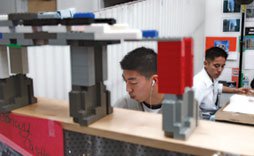Build SF: Architecting the Next Generation of Young Professionals
The Build San Francisco model turns students into aspiring designers and architects.
The Build San Francisco Institute is an academic program created by the Architectural Foundation of San Francisco designed to help high school students earn up to fifteen hours of credit learning design, engineering, and architecture skills.
Here, we provide material from Build SF for administrators creating similar learning-opportunity programs, as well as student lesson plans for building miniature golf course holes, one of the many projects Build SF offers. The material includes

Use the information on our site, or learn about partnering with Build SF on its Web site. Build SF, located in San Francisco, works in conjunction with the San Francisco Unified School District.
Who This Material Is Best For
These resources are helpful for
- teachers in grades 8-12, especially math, art, or design educators.
- school administrators who want to initiate a similar model.
- students in grades 8-12, but much of it is adaptable to other grade levels.
How to Use this Material
The materials (lessons, videos and tips, articles, and contacts) can be viewed in any order. Everything is customizable to your teaching style and academic requirements.
Through the six-part lesson plan, students design, present, and build holes for miniature golf courses in accordance with design and math standards. Each lesson includes objectives, required materials, a plan, and assessment strategies. Information can be used to supplement current lesson plans or used in their entirety. If implementing entire lessons, reserve about four to six hours for each lesson, which can be extended across a semester or completed over several weeks.
Students progress from creating designs on graph paper all the way to three-dimensional software. The project climaxes when students present their golf-hole designs. As a project extension, designs can be built using cardboard and a free corner of the classroom, or with help from community members at an actual event.
Although the lessons are focused on material for teaching students, the Articles, Videos and Tips, and Contacts sections also include materials for administrators, such as setting up a similar program and tips.
What Build SF Is About, and Why We Picked It
More than thirty local firms sponsor Build SF, an academic program created in 1993 by the Architectural Foundation of San Francisco. Each semester, every Build SF student gets the chance to work for a leading local firm, choosing from fields including architecture, engineering, interior design, landscape architecture, historic preservation, contracting, construction, and more. Build SF students develop real-world communication and work skills by solving real problems and by being mentored by professionals from local design and civic organizations.
The Build SF program invests in components we've found critical for long-term student achievement -- project learning through class curriculum and community interaction with mentors. Of the many academically rigorous projects Build SF offers in urban sociology and civic and architectural design, we've chosen the golf-course project as a fun and manageable way to emphasize math, design, and twenty-first-century learning skills through project learning.
Through third-party assessment, Build SF has developed a system to measure students' progress in each of several key learning-skills areas.
What Build SF Is Designed to Teach Students
These resources will help students develop skills in
- math, including measurement, estimation, and geometry.
- art and design, such as visualization, orthographic drawing, three-point perspective, composition, and layout.
- twenty-first-century learning -- for example, oral communication, teamwork, problem solving, and professionalism.
- three-dimensional rendering.
Background Information
This material, provided by Build SF, is funded in part by a generous grant from the Charles Stewart Mott Foundation.
To learn more about successful full-time learning, read "Reforming the School Day: The Evolution of Full-Time-Learning Programs."